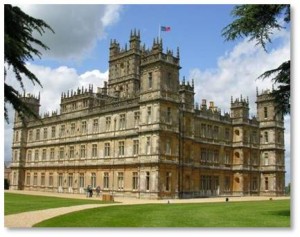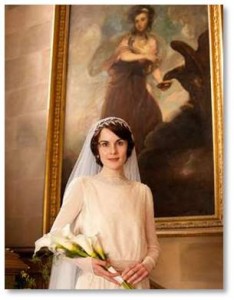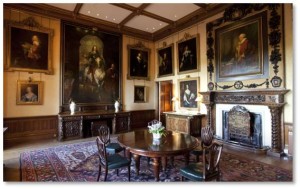Speaking as a docent and tour guide for Boston By Foot, I was very disappointed in the Crawley family on Sunday night’s episode of Downton Abbey. They gave completely substandard tours to the common people who shelled out their hard-earned pence for a tour of the great house. Even the New York Times was impelled to comment on the inadequacies.
The family members were frightfully unprepared, knew woefully little about the building in which they lived, and demonstrated a dismaying lack of curiosity about the fittings, furnishings , and paintings that surround them every day. No @BostonByFoot docent could pass the final exam with so little information, much less hit the street to lead a tour.
Baron Julian Fellowes probably wanted to make the point that the Crawley family took the house for granted and thus showed little curiosity about it. As F. Scott Fitzgerald said in his short story, “The Rich Boy”
“Let me tell you about the very rich. They are different from you and me. They possess and enjoy early, and it does something to them, makes them soft where we are hard, and cynical where we are trustful, in a way that, unless you were born rich, is very difficult to understand.”
The fans of @DowntonAbbey lost out in this episode, though. Here was a chance for us to learn more about the house and I was looking forward to it. I have never taken the Downton Abbey tour in England or visited Highclere Castle, where the series was filmed. I wanted to know more. Yet we viewers got the same weak tea as those poor folks touring the house. Well, I’m not satisfied with that, so here are answers to some of the questions that arose.
Was It Really an Abbey?
The real Highclere Castle was never an abbey but it was built on a very old site that is listed in the Domesday Book and was owned by the Catholic Church from the eighth century. A medieval palace was built there for the Bishops of Winchester in the twelfth and thirteenth centuries, followed by a red brick Tudor house.
Had it been an actual abbey, it would have disappeared as a religious house during the Reformation on the orders of King Henry VIII. The dissolution of the monasteries began in 1536 and was one of the ways in which King Henry smashed the power and looted the wealth of the Catholic Church in England. Monasteries were dissolved and sold to sympathizers and favorites to raise revenue for the crown. In the event that the Abbott or other religious leader refused, he was executve and his monastery destroyed. Just FYI, here’s a list of monasteries dissolved by Henry VIII.
By the way, @HighclereCastle does not have the structure of an abbey, which normally included a church or chapel as well as a refectory for the monks to eat in, and a dormitory for sleeping. The real Downton Abbey looks more like, well, a castle. It is owned by the Earl and Countess of Carnarvon and has been the setting for Miss Marple and Bertie Wooster in previous television dramas.
Who Designed Downton Abbey?
Lady Cora had a vague idea that Downton was designed by the same Barry who had finished the Houses of Parliament. Half a gold star to her for knowing that. The original Highclere Castle was redesigned and remodeled in the Jacobethan style by Sire Charles Barry from 1839 – 1842. That was after Sir Charles had finished building the Houses of Parliament along with Augustus Pugin. (Ironically, Mr. Pugin was a Catholic architect.)
Sir Charles Barry said that his design for Highclere was based on three qualities: love of extravagance, love of the past, and love of ancestry. All three are readily on display in this great country house.
What Paintings Hang in Downton Abbey?
Although the Earl of Grantham may have dismissed the paintings as of little consequence, the collection is extensive.
Note: The Fifth Earl of Carnarvon discovered the tomb of Tutankhamun with Howard Carter in 1922. Well, he funded the expedition but it was Howard Carter who crawled through the hot dusty passageway and broke through the tomb door. When asked what he saw in the lamplight, he replied, “Things, wonderful things.” One might say the same of the treasures in Highclere Castle.
In the early eighteenth century, the Hon. Robert Sawyer Herbert began collecting the art that we see on the walls in each episode. It includes many portraits of the earls and countesses of Carnarvon as well as their children.
The artists and sculptors represented include Sir Joshua Reynolds, Anthony van Dyck, Piero Della Francesca, Sir Peter Lely, Sir William Beechey, and Lorenzo Bartolini. The portrait of “Charles I with m de St. Antoine” by Anthony van Dyck that hangs above Lord Grantham’s seat in the dining room is worth £17M. Any museum would be delighted to have such a collection, as the newly formed National Gallery did when its representative, Simon Bricker, courted Lady Cora to obtain the donation of a “minor” work.
That’s a mere fraction of what the real docents at Highclere Castle probably tell visitors fortunate enough to get an authentic tour. But it’s more than the Crawley family had to say. And no, I don’t know why those marble shields on the fireplace surround have no heralding crests carved on them. Maybe the Countess of Carnarvon knows.



